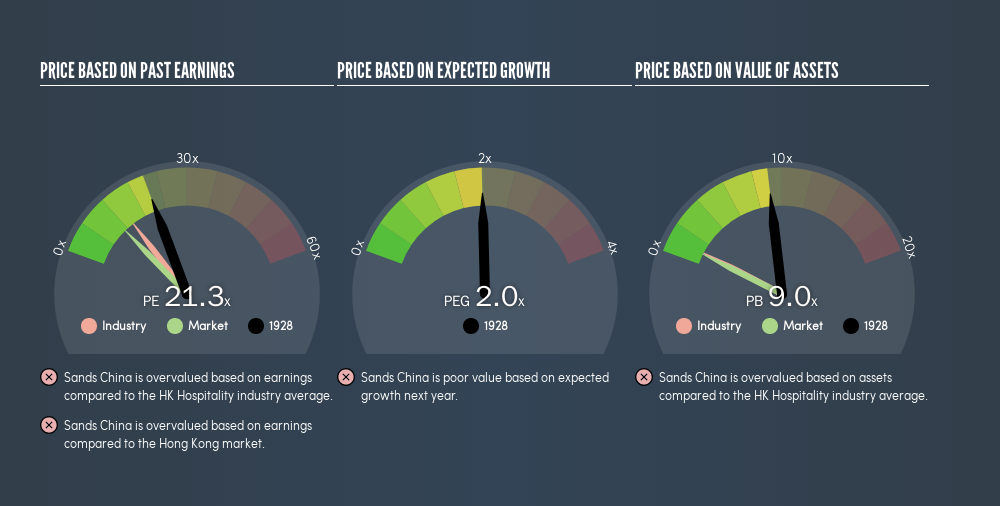- Hong Kong
- /
- Hospitality
- /
- SEHK:1928
Despite Its High P/E Ratio, Is Sands China Ltd. (HKG:1928) Still Undervalued?

This article is written for those who want to get better at using price to earnings ratios (P/E ratios). We'll show how you can use Sands China Ltd.'s (HKG:1928) P/E ratio to inform your assessment of the investment opportunity. Based on the last twelve months, Sands China's P/E ratio is 21.27. In other words, at today's prices, investors are paying HK$21.27 for every HK$1 in prior year profit.
Want to participate in a short research study? Help shape the future of investing tools and you could win a $250 gift card!
View our latest analysis for Sands China
How Do I Calculate Sands China's Price To Earnings Ratio?
The formula for price to earnings is:
Price to Earnings Ratio = Share Price (in reporting currency) ÷ Earnings per Share (EPS)
Or for Sands China:
P/E of 21.27 = $4.94 (Note: this is the share price in the reporting currency, namely, USD ) ÷ $0.23 (Based on the trailing twelve months to December 2018.)
Is A High Price-to-Earnings Ratio Good?
A higher P/E ratio means that investors are paying a higher price for each HK$1 of company earnings. That isn't a good or a bad thing on its own, but a high P/E means that buyers have a higher opinion of the business's prospects, relative to stocks with a lower P/E.
How Growth Rates Impact P/E Ratios
Probably the most important factor in determining what P/E a company trades on is the earnings growth. If earnings are growing quickly, then the 'E' in the equation will increase faster than it would otherwise. And in that case, the P/E ratio itself will drop rather quickly. Then, a lower P/E should attract more buyers, pushing the share price up.
Sands China increased earnings per share by an impressive 17% over the last twelve months. And it has improved its earnings per share by 8.7% per year over the last three years. With that performance, you might expect an above average P/E ratio. In contrast, EPS has decreased by 3.3%, annually, over 5 years.
How Does Sands China's P/E Ratio Compare To Its Peers?
The P/E ratio indicates whether the market has higher or lower expectations of a company. The image below shows that Sands China has a higher P/E than the average (14) P/E for companies in the hospitality industry.

That means that the market expects Sands China will outperform other companies in its industry. Clearly the market expects growth, but it isn't guaranteed. So investors should delve deeper. I like to check if company insiders have been buying or selling.
Don't Forget: The P/E Does Not Account For Debt or Bank Deposits
It's important to note that the P/E ratio considers the market capitalization, not the enterprise value. That means it doesn't take debt or cash into account. Hypothetically, a company could reduce its future P/E ratio by spending its cash (or taking on debt) to achieve higher earnings.
Such spending might be good or bad, overall, but the key point here is that you need to look at debt to understand the P/E ratio in context.
Sands China's Balance Sheet
Net debt totals just 7.4% of Sands China's market cap. It would probably trade on a higher P/E ratio if it had a lot of cash, but I doubt it is having a big impact.
The Verdict On Sands China's P/E Ratio
Sands China's P/E is 21.3 which is above average (11.1) in the HK market. Its debt levels do not imperil its balance sheet and it is growing EPS strongly. So on this analysis it seems reasonable that its P/E ratio is above average.
Investors should be looking to buy stocks that the market is wrong about. People often underestimate remarkable growth -- so investors can make money when fast growth is not fully appreciated. So this free visualization of the analyst consensus on future earnings could help you make the right decision about whether to buy, sell, or hold.
Of course you might be able to find a better stock than Sands China. So you may wish to see this free collection of other companies that have grown earnings strongly.
We aim to bring you long-term focused research analysis driven by fundamental data. Note that our analysis may not factor in the latest price-sensitive company announcements or qualitative material.
If you spot an error that warrants correction, please contact the editor at editorial-team@simplywallst.com. This article by Simply Wall St is general in nature. It does not constitute a recommendation to buy or sell any stock, and does not take account of your objectives, or your financial situation. Simply Wall St has no position in the stocks mentioned. Thank you for reading.
About SEHK:1928
Sands China
Develops, owns, and operates integrated resorts and casinos in Macao.
Solid track record and good value.
Similar Companies
Market Insights
Community Narratives



